The Kalahari Desert
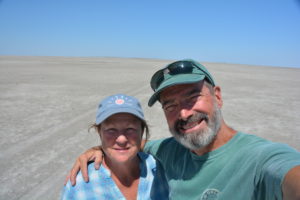
The Kalahari desert had a little bit of everything but we particularly liked the huge barren salt pans that dominated the northern region
The Kalahari Desert is a harsh dry environment stretching across many countries in southern Africa but its heart and soul, and its most extreme conditions, are in central Botswana. Here the sand is deep and the low thorny scrub, long golden grasses and dry salt pans dominate. The last river in these parts stopped flowing about 16,000 years ago. Animals out here have to be able to survive these conditions and that’s why the beautiful Gemsboks, Steenboks and Springboks are on a shortlist of animals to see. Bring it on!
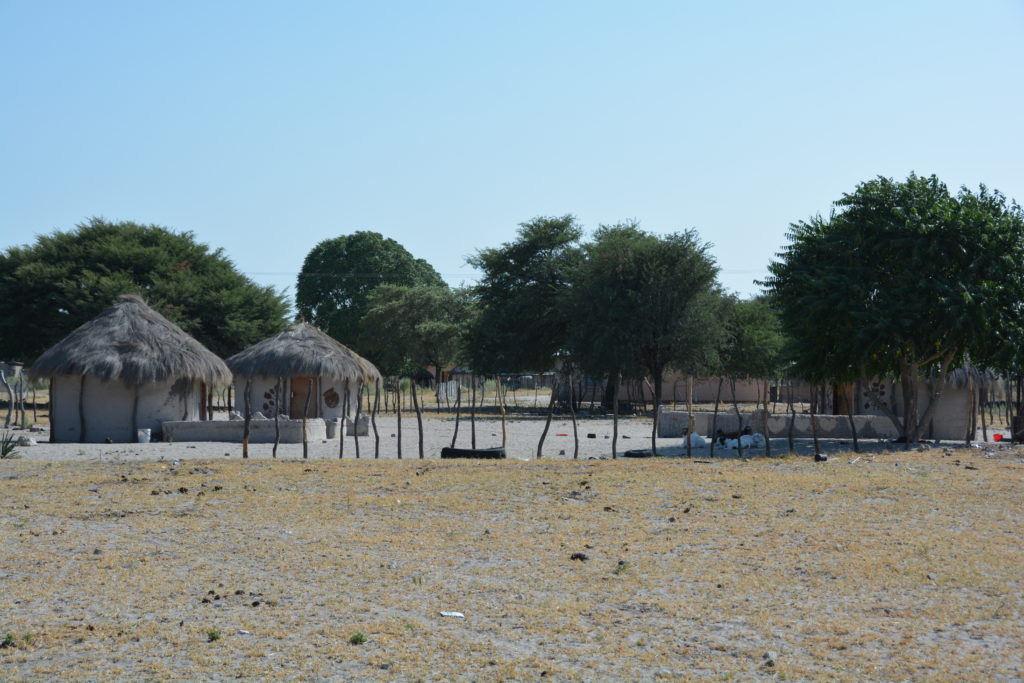
The communities living on the edge of the Kalahari desert were some of the most basic we saw in Botswana
After camping at a beautiful spot on the Boteti River west of the regional town of Maun, the sounds of hippos, donkeys and frogs competing for attention, we headed further east and entered Nxai Pan National Park, the northern most extension of the expansive Kalahari Desert and home to some of the most famous trees in Africa.
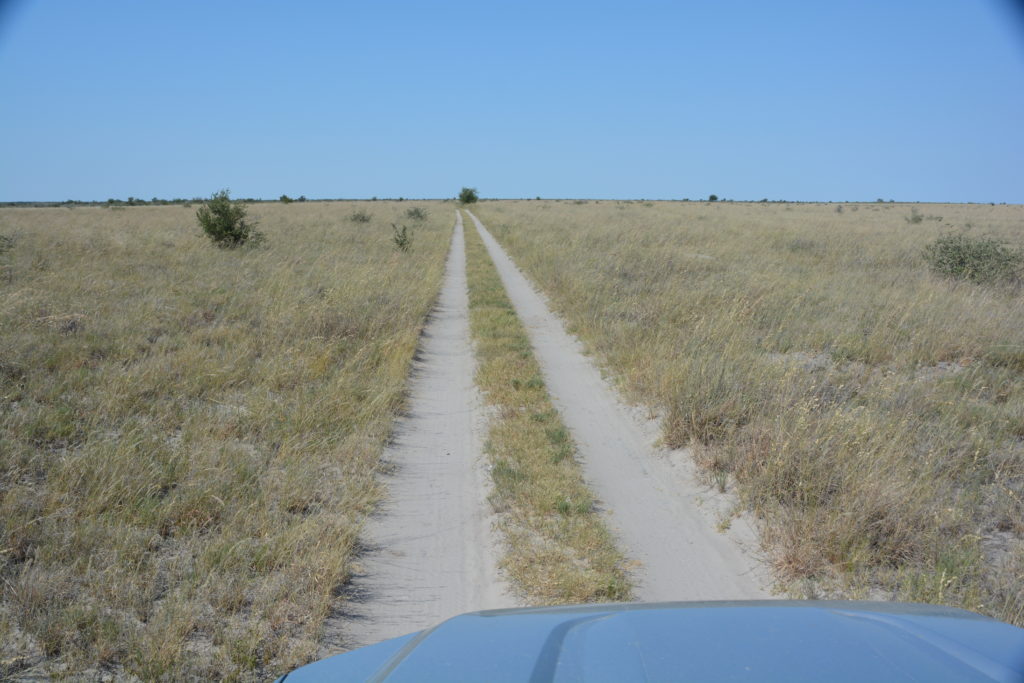
The tracks in this part of the desert were clear and easy but we went for hours without seeing another vehicle
In the 1850’s the Scottish botanist, naturalist and artist Thomas Baines came across a grove of giant baobab trees growing in the middle of the dry pans, or lake beds, in what is now Nxai Pan National Park. He camped there and painted these huge trees, immortalising a scene no European had seen before. Today these trees still stand as big and proud as they did in his day and Julie and I followed the rough track out to this remote place to walk amongst them, stunned by their enormous size and marveling at both their age and their unique place.
We drove further north through the park’s desert scrub, the land dry as the moon and only slightly more hospitable, sighting two new animals we hadn’t seen before, the lithe little Steenbok and the imposingly impressive Gemsbok. The Gemsbok has probably the finest horns of any animal in Africa, over a metre long, sticking straight up, demanding attention and respect while the animal itself features beautiful markings on his face and body, a magnificent beast.
We also enjoyed the elephants spraying themselves with mud to keep cool in the stinking hot sun, the graceful Springbok which made a reappearance on our animal hit list and the ostriches which seem to flourish in this harsh land.
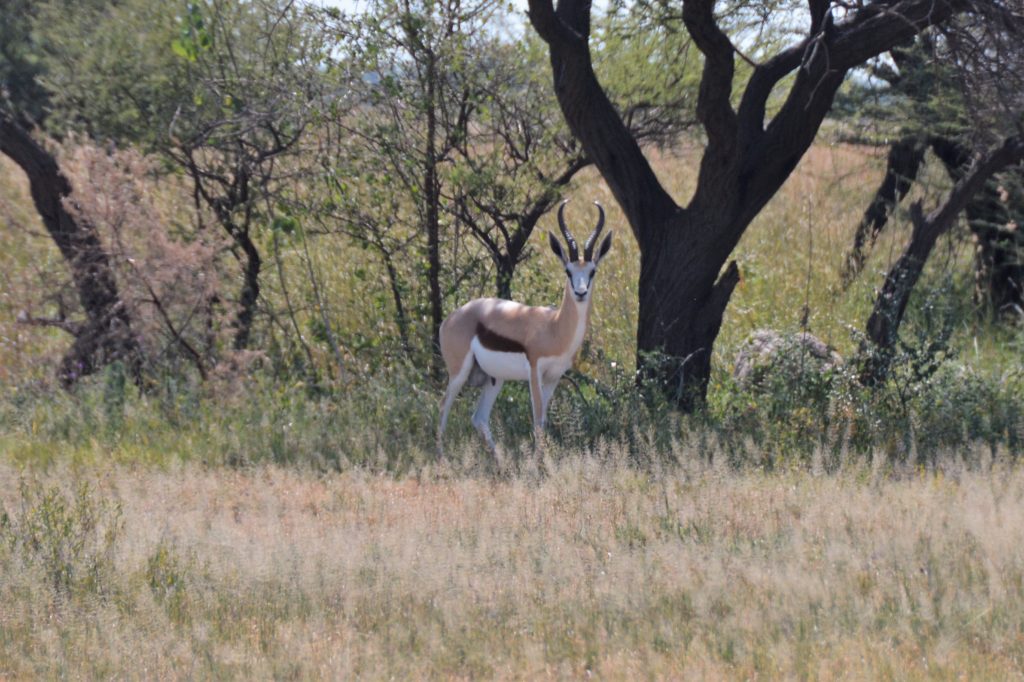
The distinctly marked Springbok, South Africa’s national animal and probably the most recognisable antelope in all of Africa
We camped that night in the desert town of Gweta in the grounds of a pleasant little lodge, enjoying their bar and Wi-Fi before dinner. After lowering the pressure in our tires for the umpteenth time, the next morning we headed south, or tried to, but it took four kids to lead us through the narrow dusty tracks of the village, past the mud plaster and thatched roof rondavels, and into the thornveld scrub. We relied heavily on our beloved GPS to keep us on one of the many tracks that guided us in the right direction.
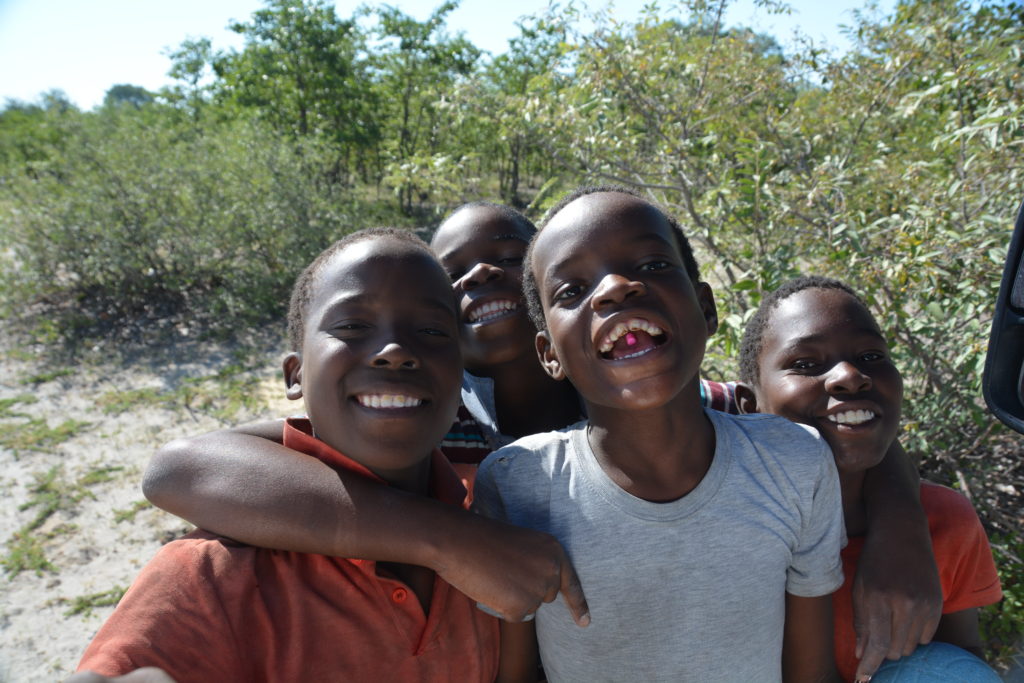
These kids saved us from being trapped in Gweta’s narrow tracks forever by showing us the way out – and were rewarded with lollies
Our goals for the morning might sound modest – we wanted to find two famous baobab trees that had enjoyed a long life in the middle of nowhere. To get there we followed ever-decreasing tracks, sometimes just cattle tracks, squeezing through the endless supplies of thorn bushes that left African souvenirs on the side of Tramp, until we found Greene’s Baobab. Discovered by the Greene brothers’ expedition in 1880 this lone tree has ballooned out into the monster beast it is, scarred by the Greene’s and others leaving their carved marks on its sides.
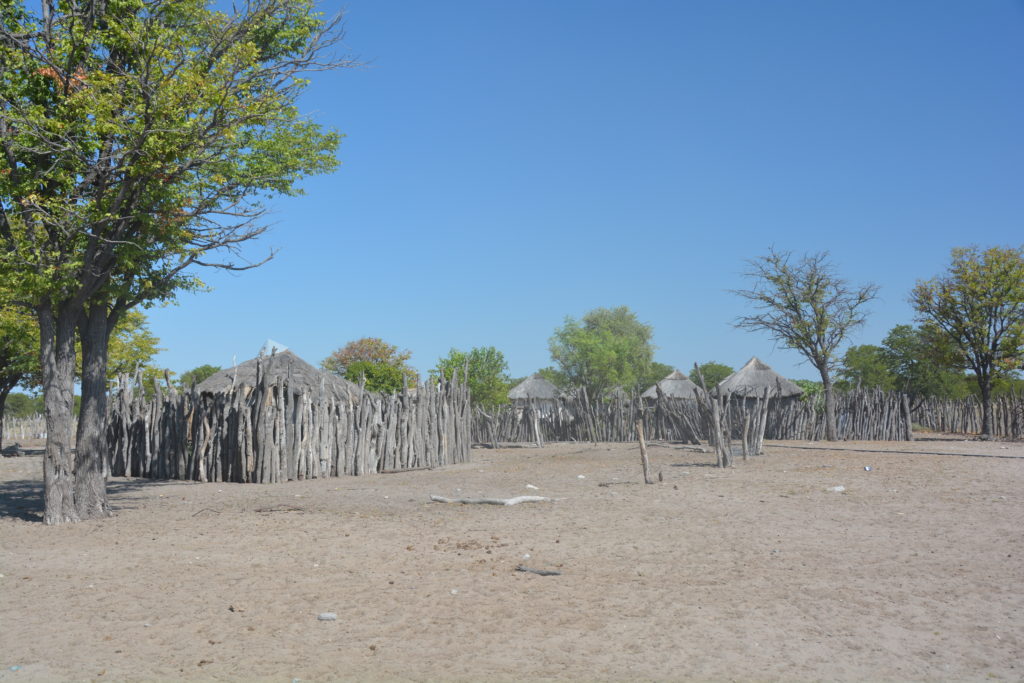
We came across this very primitive village with stick fences and huts – what a hard life these people must live
Not done with baobabs or narrow unrecognisable sandy tracks, we continued on to Chapman’s Baobab, named after his discoverer in the 1860’s, said to have a girth of 25 metres (over 80 feet) before it split in three pieces and fell down a few years ago. Amazingly, the tree is still alive and continues to sprout new branches, even though visitors like Julie and I climb all over it. Said to be between 500 and 4,000 years old, depending on your source, Chapman’s Baobab sets a high bar for size and remoteness.

To finish our day of monster trees, Chapman’s Baobab is – or was – the biggest of them all until it split and fell a few years ago
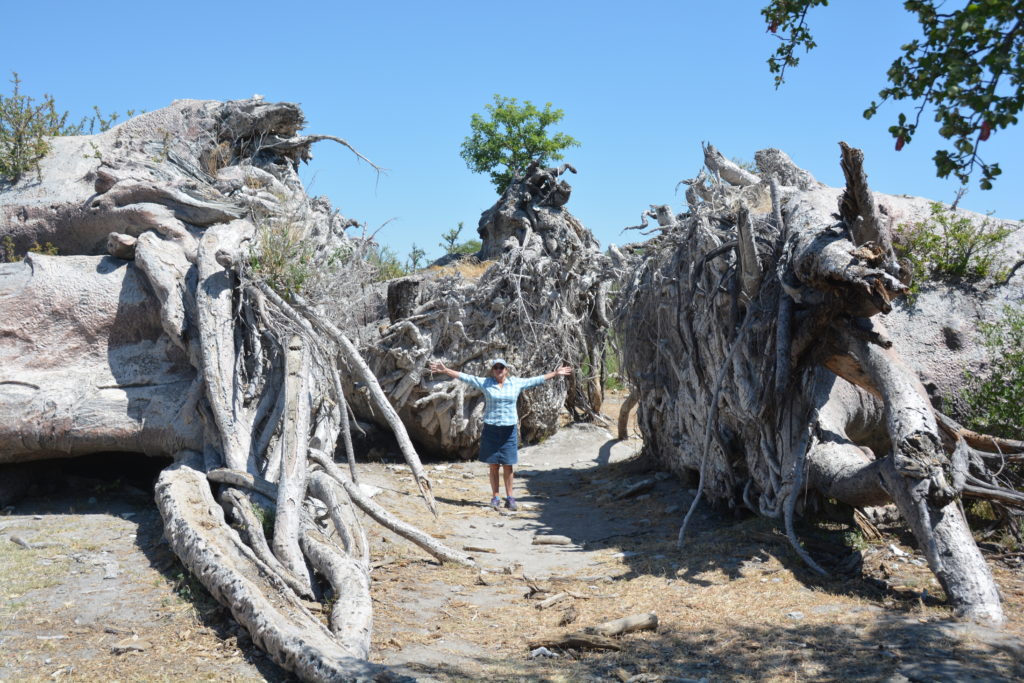
Julie is standing in the middle of what was the baobab trunk before it split into different pieces and fell apart
South again it was, following our compass and a vague track, until we found the edge of the Nwetwe Pan, a vast flat open expanse of dried salt that stretched beyond what we could see. We knew from our experience on the Salar de Yuni in Bolivia that salt pans can be dangerous to drive on when they are soft or wet but the Nwetwe was dry and solid, allowing us to follow the vague track off into its vast nothingness.
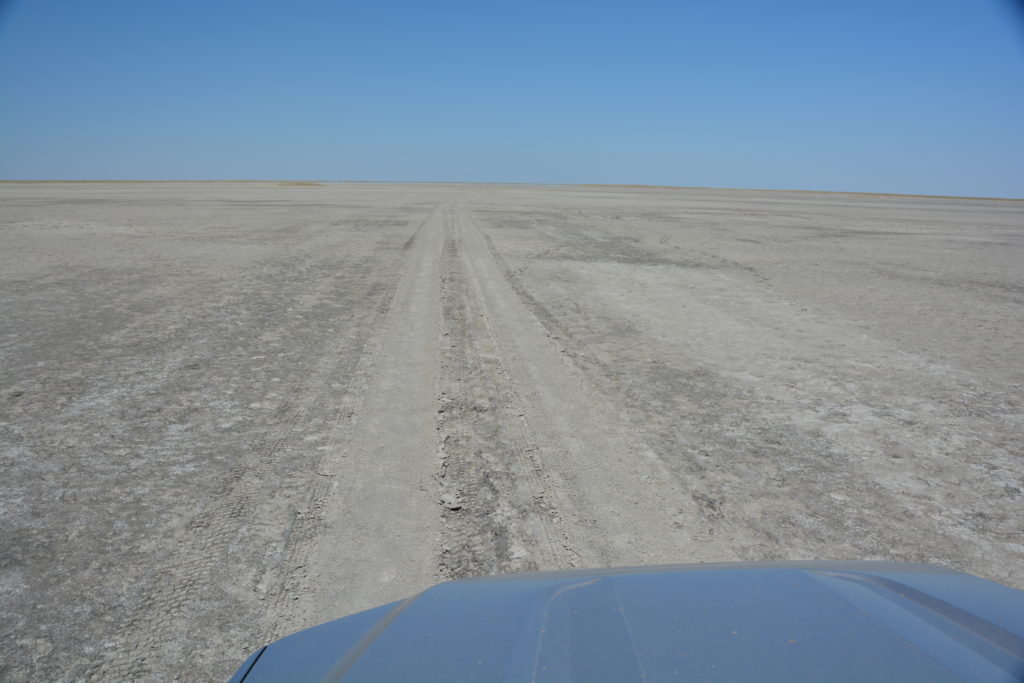
Oh my, we hit the edge of the Nwetwe salt pan and had to be careful to follow the vague track across this nothingness

Tramp must have felt as lost and confused as us with absolutely no marker or point of reference in any direction
This is where horizons, texture, depth of field and direction become completely lost, where the world looks the same in all directions. We had a huge lake out in front of us, in fact all around us, but we never could reach it, the mirage constantly shifting further from us as we approached. When driving on salt flats water is very bad so we couldn’t help a few nervous laughs as the mirage surrounded us.
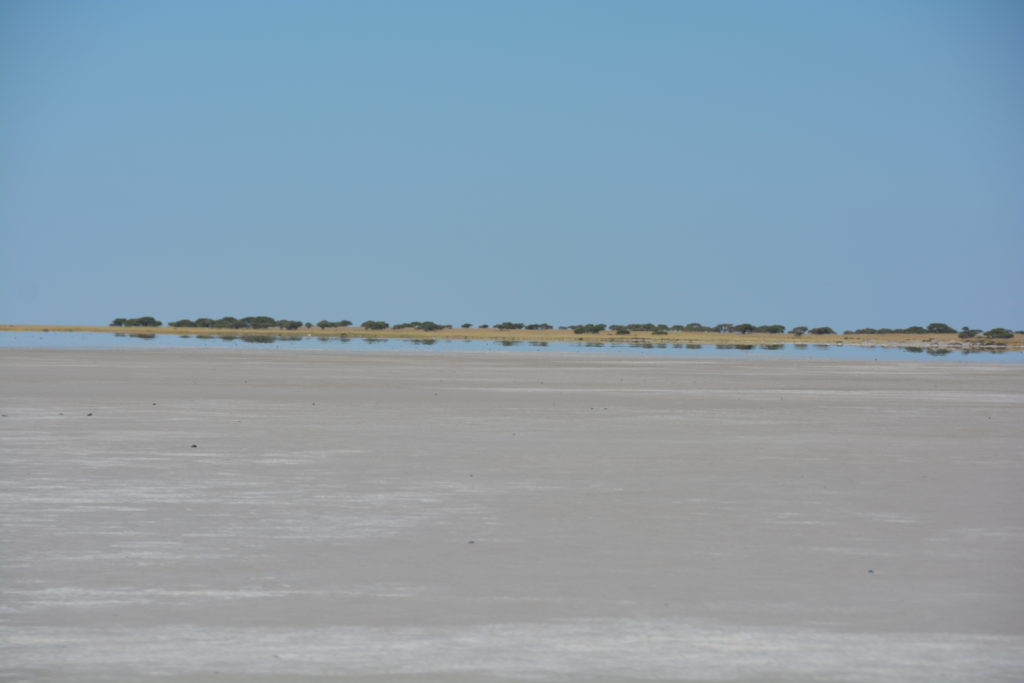
Mirages are not easy to photograph by definition but I caught this scene on the far side of the salt pan – no that’s not water
After a lunch stop in the middle of nowhere we finished the Pan crossing and eventually made the double buffalo fence, erected to stop the spread of Hoof and Mouth Disease, and with the advice of the lonely inspector in this forsaken place, we followed the fence about 80 kilometres until we reached the paved road which bisects the northern parts of the Kalahari Desert. What a fabulous experience this crossing from Greta to the road had been!

The track was easier to follow once we reached some grassy patches but we still had a ways to go before civilisation again
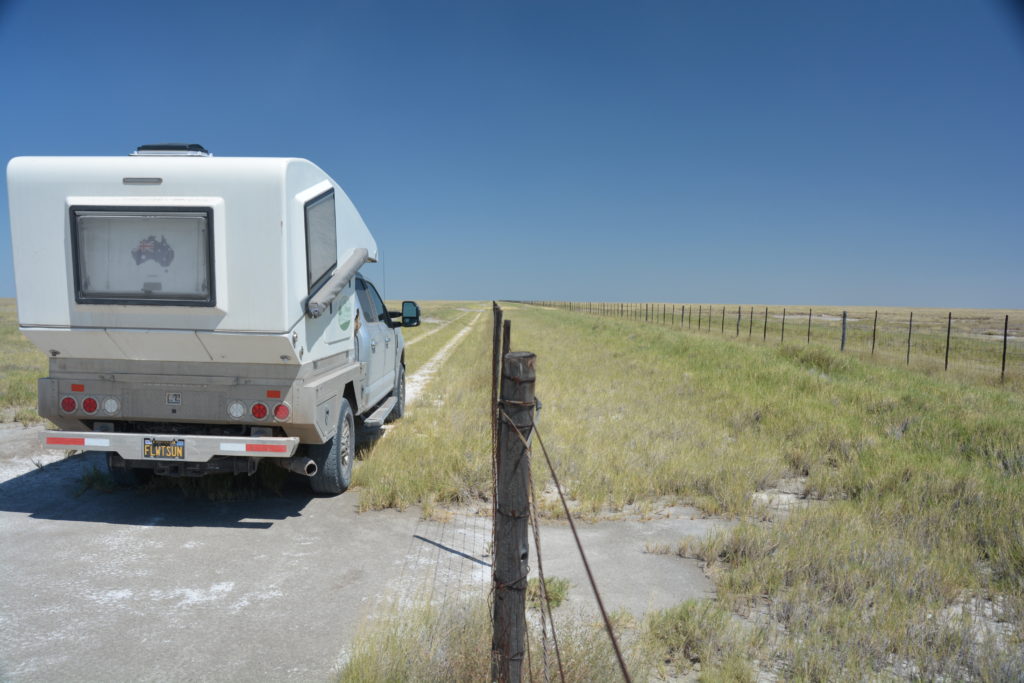
The amazing buffalo fence across Botswana rivals the rabbit fence in Australia and we travelled along it for 80 kilometres
After filling all our tanks with every drop we could carry in a grimy little town on the paved road we headed south again across soft tracks for the heart of the Kalahari. We bush camped that night amongst the low scrubby thorn trees off the sandy track and enjoyed the stars in this most exquisite of places.
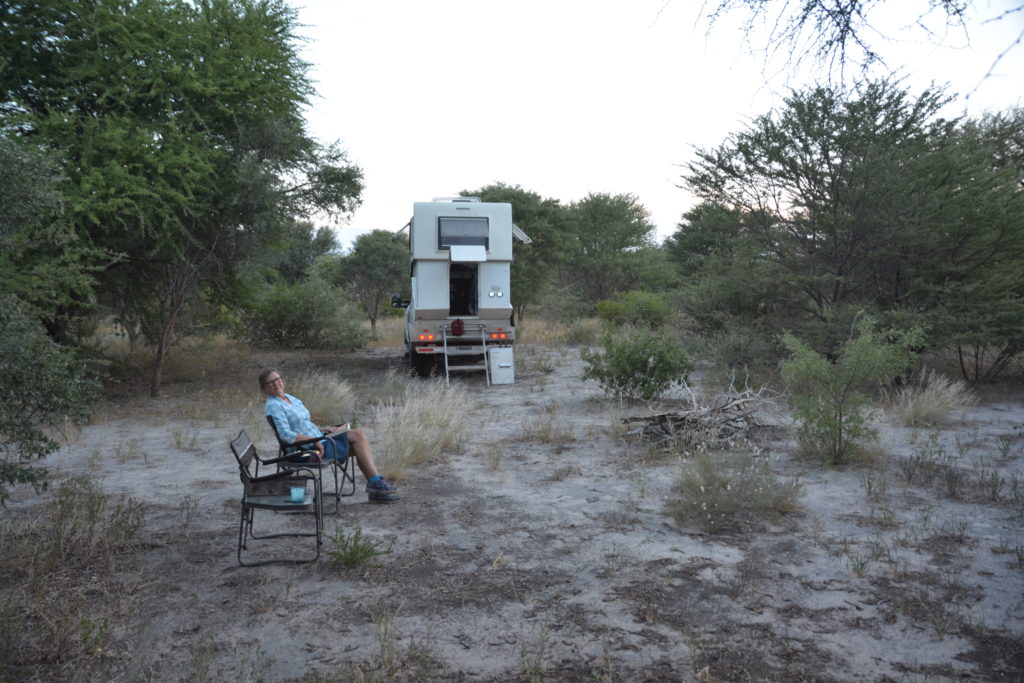
A rare camp in the wild bush before crossing into the Kalahari game reserve the following morning – check out the collected wood ready for the fire right after this photo
The distances across the desert are vast and of course there are no services or infrastructure at all. We had to book our two nights at designated campsites in advance and carefully calculated the range Tramp could cover with the 180 litres (48 gallons) he could carry plus stock up on enough water and beer to ensure we could pop out the other side. Hoping not to run out of any of these, and knowing which one is the most important, we followed the sandy track towards Deception Valley in the heart of the central Kalahari.
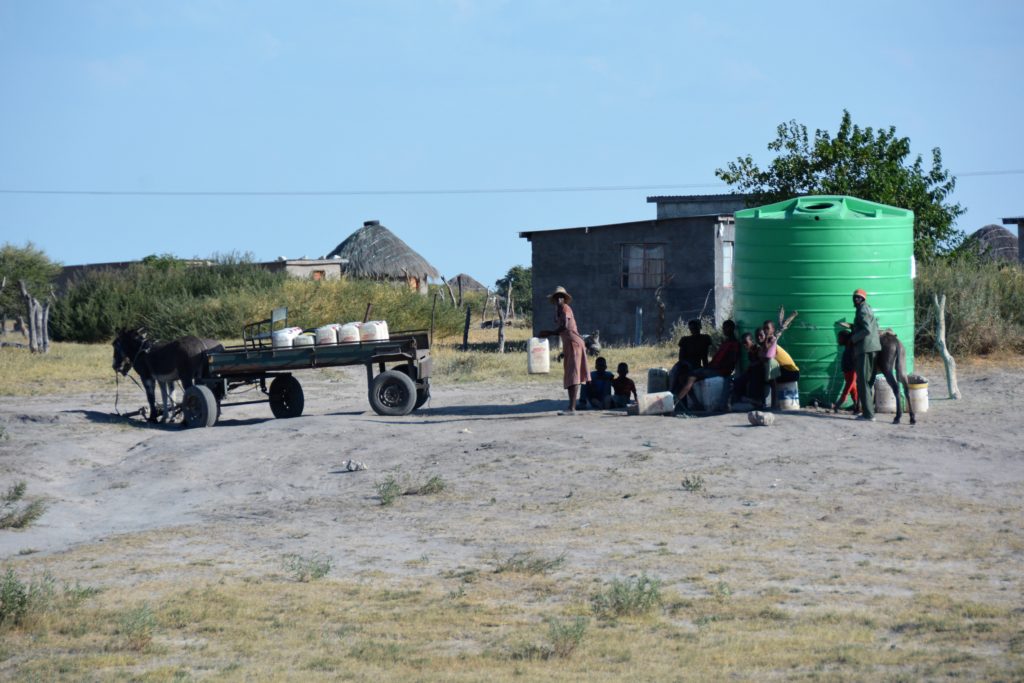
On the edge of the central Kalahari water is king and this village’s hand pump is the centre of attention for all the locals
As is the practice of the Botswana government in other parks, they now pump water from bore wells using solar panels at designated waterholes during the dry season or in drought to ensure the animals have enough water to survive. We headed across dry salt pans and over scrub-covered sand hills to Sunday Waterhole, spotting many Gemsboks along the way. We never tired of Gemsboks, no creative designer or graphic artist could come up with a more majestic creature.
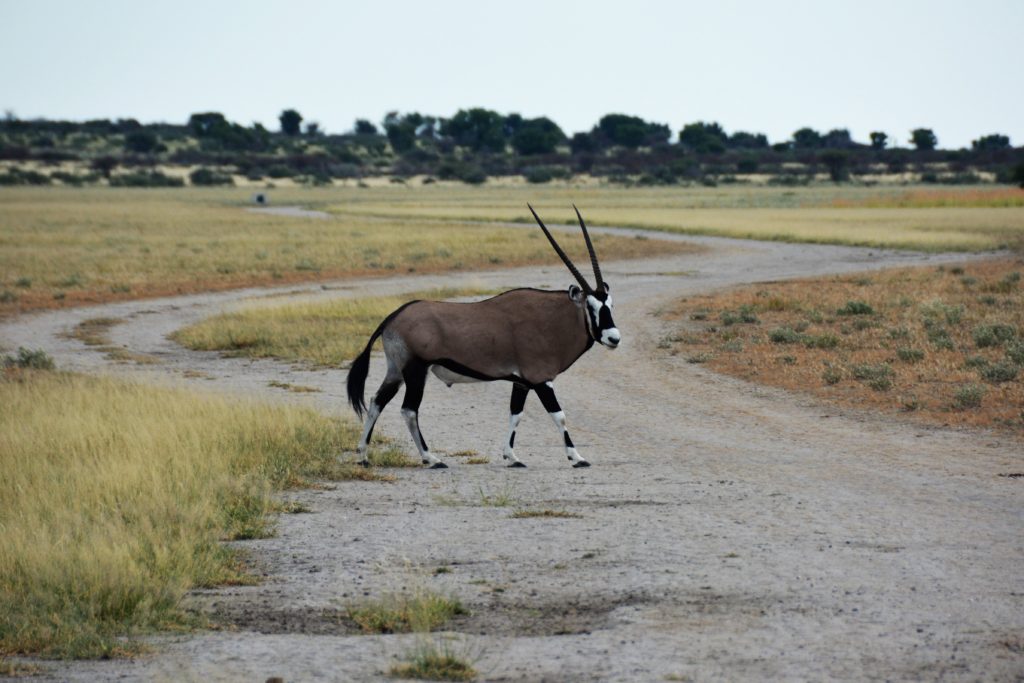
The beautifully marked gemsbok, our favourite new African animal, was soon a common sight in the desert
But we must have been to Sunday Waterhole on the wrong day of the week because there was no action there so we explored more stretches of Deception Valley, its animals and its stark grandeur. We camped that night amongst a grove of trees near the edge of the pan, the blazing fire, a canopy of stars, the sounds of lions roaring in the dark, pinching ourselves at what a special experience this has been.
We went hunting again early the following morning and based on a local tip found a cheetah gorging itself on a recent kill. Cheetahs are the rarest of animals in the African bush and it is said only about 100 live in the entire Kalahari Game Reserve. This beautiful creature with its magnificent dotted colours was bloated from her over-eating and eventually wallowed off into the shade, leaving the rest of her kill to the ravaging jackals.
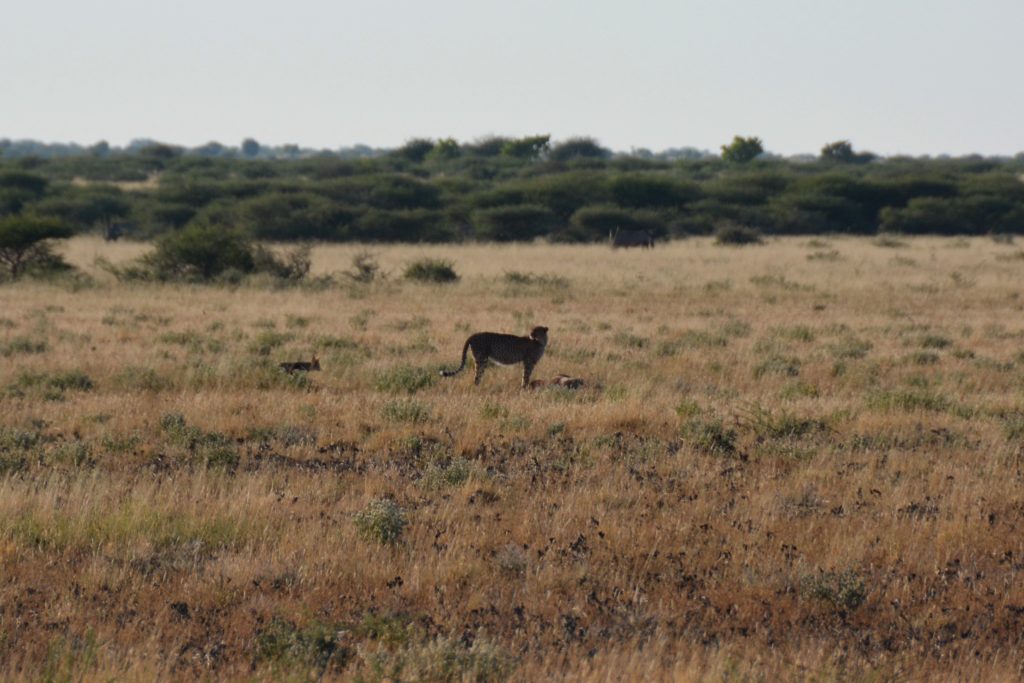
A beautiful cheetah, the only one we saw in our Africa adventure, stands over her kill as we gaze on from a safe distance
We drove south through the desert, following the track from dry pan to dry pan, spotting our first few red hartebeests as well as hundreds of wonderful gemsboks, springboks and steenboks. At one stage we found a huge male lion resting under the tree right next to the road. His mane was largely black indicating he belonged to the rare group referred to as the black lions of the Kalahari. The perfect hunting machine, this old fellow was happy for us to gaze upon him, admiring his huge and handsome features, while he slept in the shade.
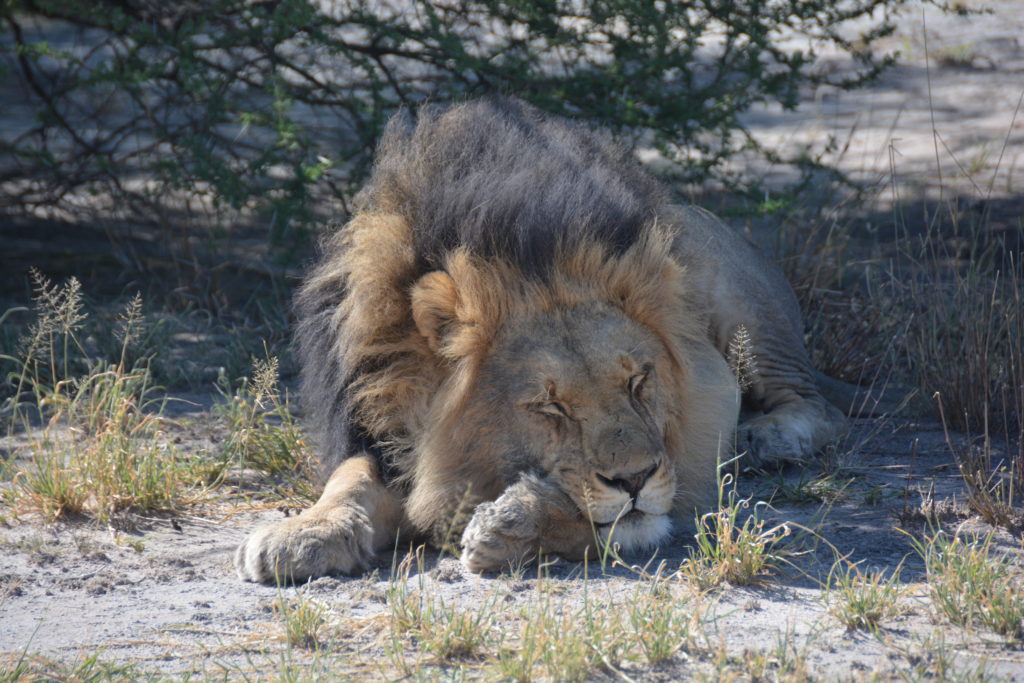
This is what you look like if you are on the top of the food chain with no fear and have just had a huge meal
We made Piper Pan, one of the permanent waterholes of the Kalahari, but no animals were there and we opted to park under some rare shade a few kilometres away for lunch. The whole afternoon was consumed by a long and tedious drive to the Xade Gate on the southern border of the park. This was killer stuff, especially for Tramp who endured many more thousands of scratches on his sides from the overgrown bushes while ploughing through the sand and enduring the 36C/94F desert heat. Tramp is our hero.

This long section of the Kalahari was just thick scrubby thorn bushes which scratched the sides of Tramp while he had to plough through the sand
The Kalahari Desert is not like the Sahara or Simpson Deserts, all sand dunes and beautiful nothingness, but more like a dry barren land of sand where some plants, especially thorn bushes, flourish. It is hot, huge, unforgiving and when not featuring a pan with possible wildlife it can be a long tough journey for both vehicle and passengers.
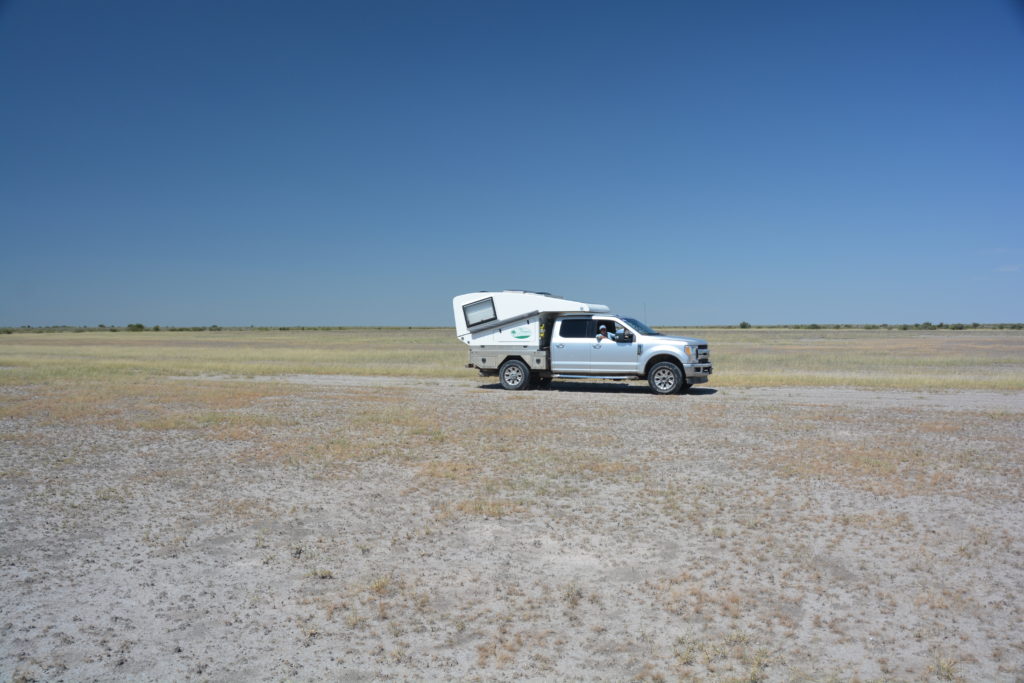
A dry pan gives Tramp respite from the relentless thorn bushes and gives us a chance to stretch our legs in relative safety
Our last morning crossing the Kalahari was a case in point. At a small waterhole we found two beautiful lions enjoying the early morning breezes on a full stomach. But then it was back on the track, deep sand, thick scrub and hard work for Tramp and his passengers. By late morning we had an improved track and by early afternoon we were in the dusty town of Ghanzi, the self-proclaimed “Capital of the Kalahari’, where we stocked up on fuel and supplies. Tramp had carried 180 litres to get across the desert and had used all but a dozen. My calculations had been tight, the sand had been demanding but we made it…just.
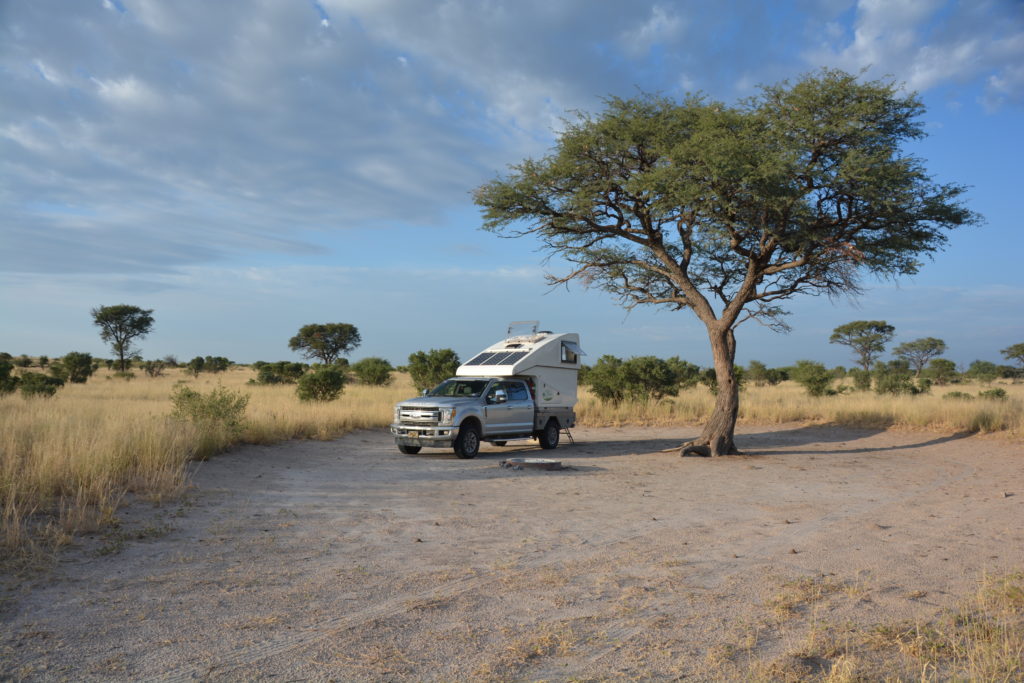
Our beautiful campsite on our last night in the Kalahari – a desert which reaches across a huge section of the southern parts of the continent
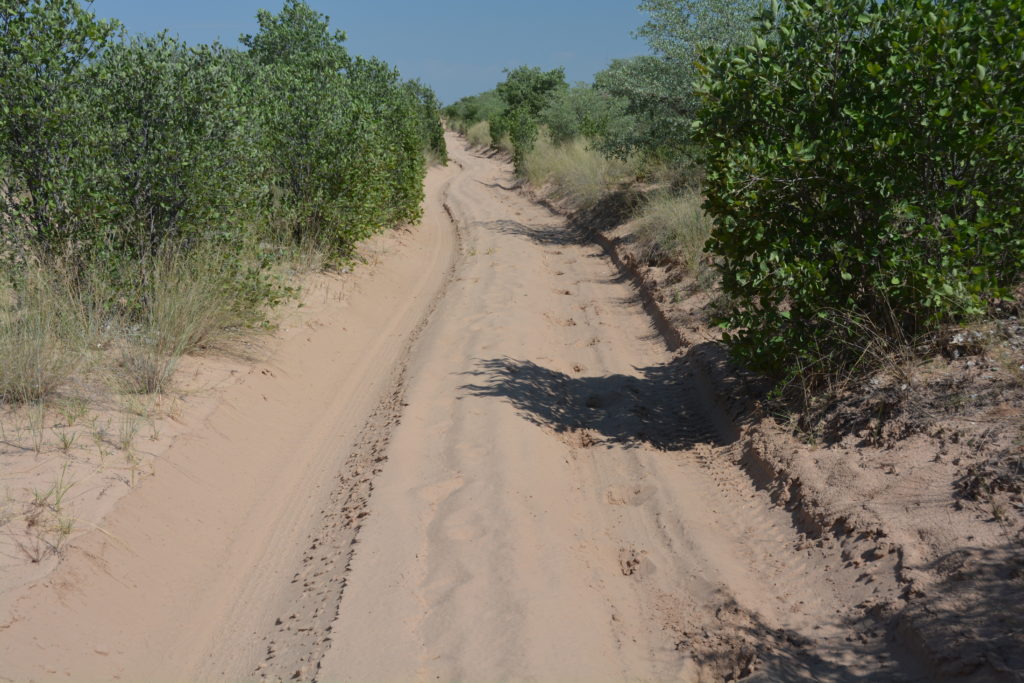
The last morning in the desert was some of the toughest for Tramp up and down these long dunes in the thick sand, made a little easier because his fuel supply was very light (and dangerously low!)
We chose a campsite that night which had a restaurant featuring local wild game and we celebrated our five days in the Kalahari by eating what we enjoyed most – Julie had Impala chops while I chose a Gemsbok steak. As you do.
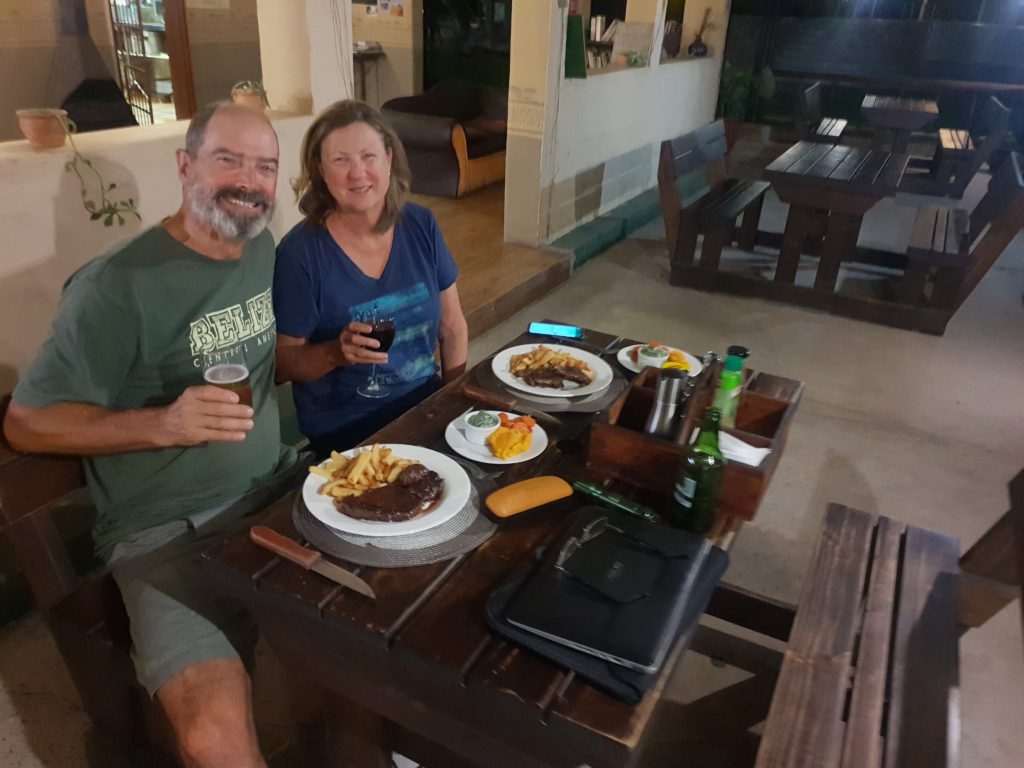
We celebrate our successful crossing of the Kalahari Desert by eating a Gemsbok steak and Impala chops
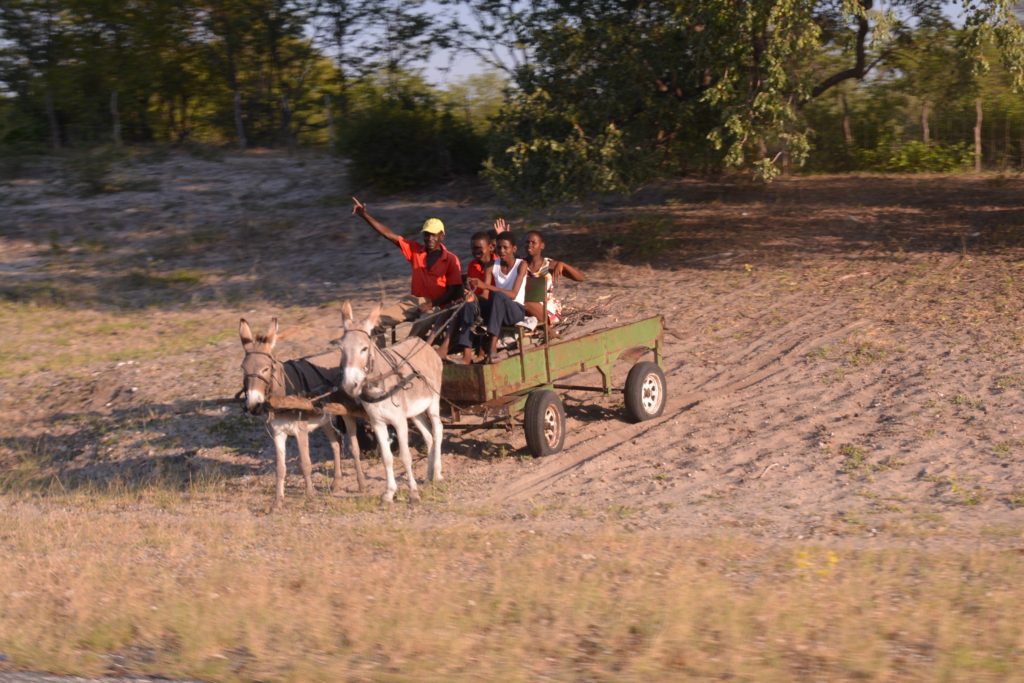
Life is not easy in central Botswana but the locals always have a smile and a wave for Tramp and his passengers
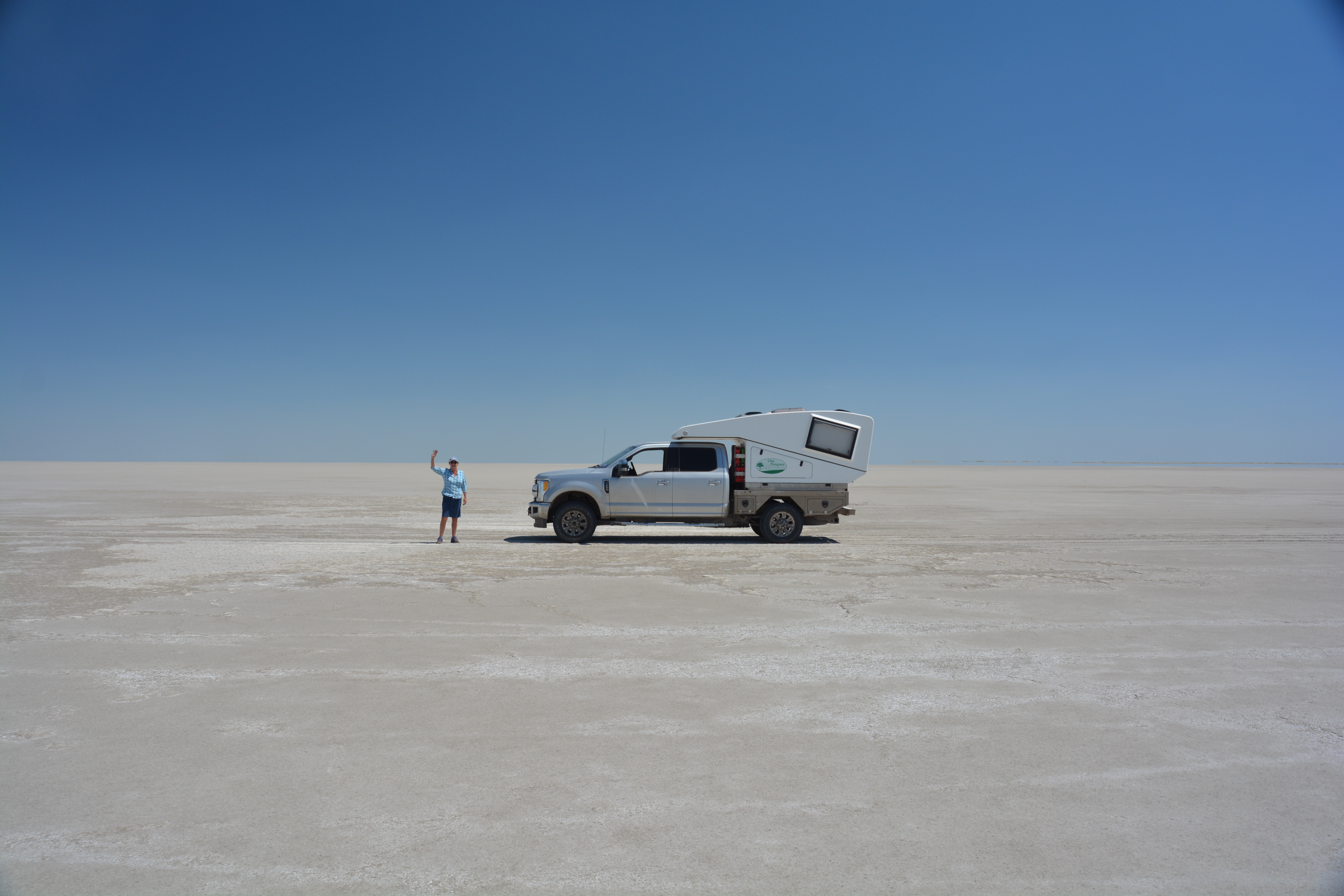








Comments
The Kalahari Desert — No Comments
HTML tags allowed in your comment: <a href="" title=""> <abbr title=""> <acronym title=""> <b> <blockquote cite=""> <cite> <code> <del datetime=""> <em> <i> <q cite=""> <s> <strike> <strong>